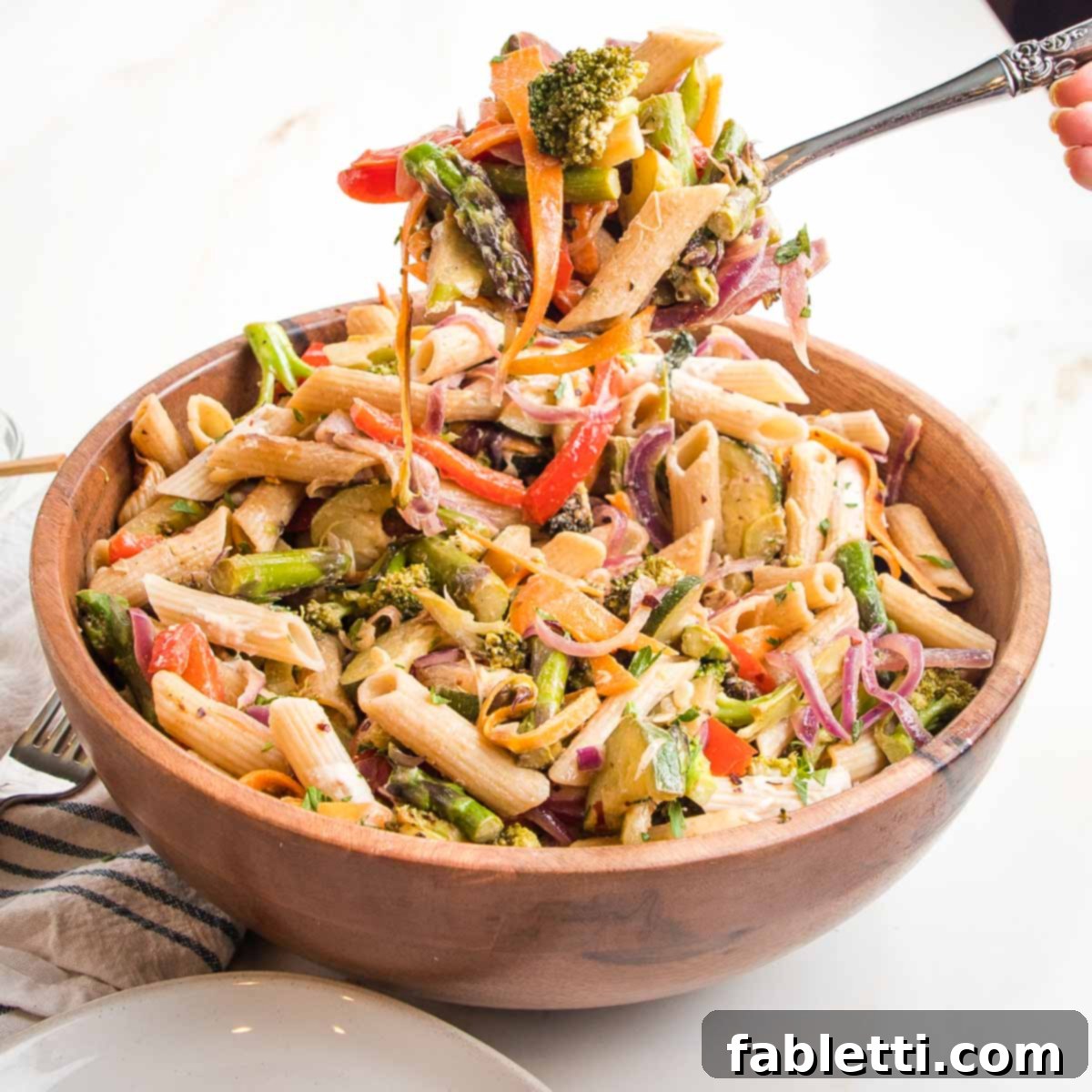Welcome to your new favorite weeknight meal: a vibrant and incredibly flavorful Vegan Pasta Primavera Recipe! This dish is the epitome of quick, healthy, and delicious, transforming a medley of fresh vegetables into a satisfying plant-based dinner. In just under 30 minutes, you can create a culinary masterpiece that’s bursting with color and taste, making it an ideal choice for busy evenings or whenever you crave something fresh and wholesome. The magic lies in a light, zesty tahini lemon sauce that perfectly coats your favorite pasta and a generous mix of seasonal vegetables, promising a delightful experience that will become a year-round staple in your kitchen.
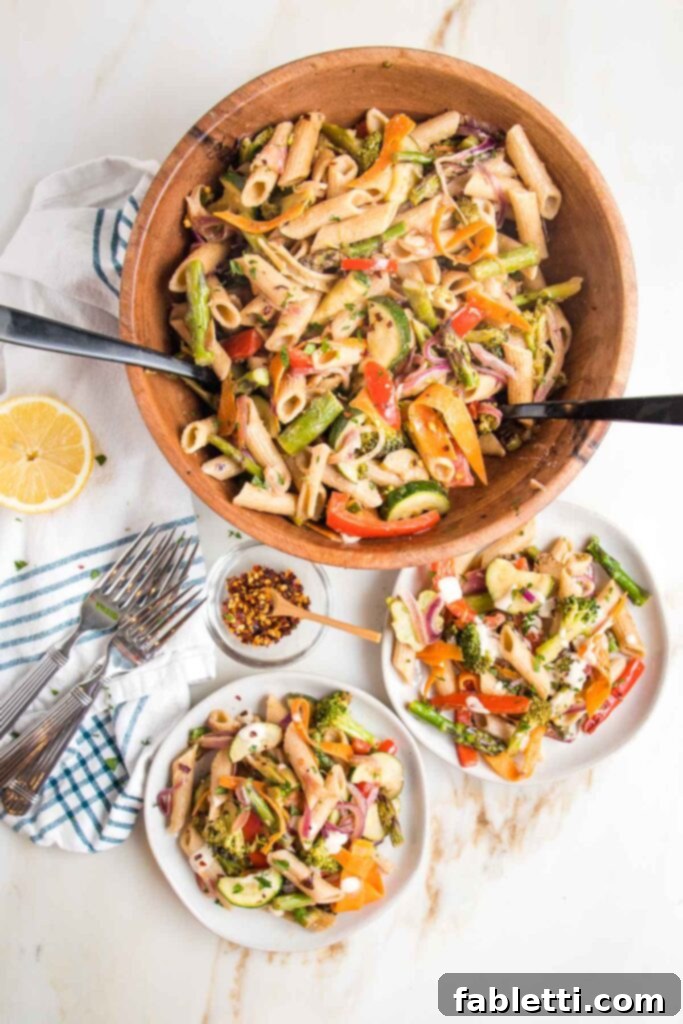
While “primavera” traditionally means “spring” in Italian, suggesting a seasonal dish, this healthy pasta primavera recipe transcends the seasons. It’s a wonderfully adaptable and super delicious way to incorporate more fresh, nutrient-rich vegetables into your diet, no matter the time of year. Whether it’s the crisp bounty of spring, the vibrant harvests of summer, or heartier greens from cooler months, this recipe invites you to celebrate the best of what nature offers.
Traditional pasta primavera often features a rich, creamy lemon sauce made with dairy. Our innovative, dairy-free version offers a lighter, yet equally indulgent, experience. It utilizes white wine and tahini to create a uniquely creamy and lemony vegan primavera sauce that is both refreshing and deeply satisfying. This clever combination delivers all the depth of flavor you’d expect from a classic primavera, but with a wholesome, plant-based twist that the entire family will adore. If you’re on the hunt for an easy, healthy, and incredibly flavorful plant-based dinner that comes together in mere minutes, your search ends here.
Why You’ll Adore This Vegan Pasta Primavera
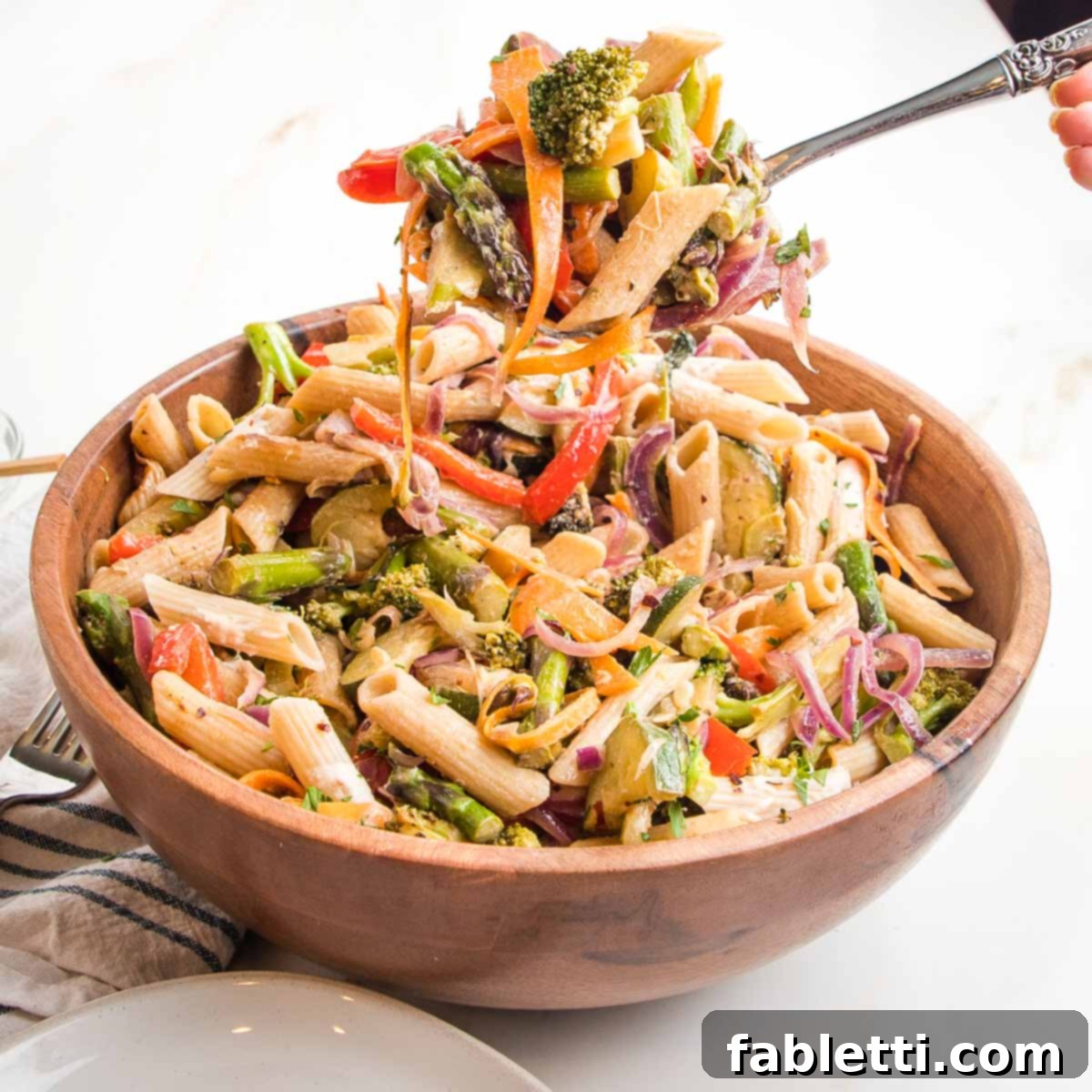
This Vegan Pasta Primavera isn’t just a meal; it’s an experience designed to delight your taste buds and nourish your body. Here’s why it’s destined to become a beloved recipe in your collection:
- Perfectly Balanced: It’s remarkably light, thanks to its dairy-free, zesty lemon-tahini sauce, yet incredibly filling and satisfying. You’ll feel energized, not weighed down, making it perfect for any time of day.
- Nutrient Powerhouse: This dish is a celebration of fresh produce, offering a super tasty and effortless way to boost your daily vegetable intake. Each bite is packed with vitamins, minerals, and antioxidants, contributing to your overall well-being.
- Ultimate Vegan Comfort Food: Craving pasta but want something healthy? This recipe delivers! It balances the comforting familiarity of pasta with a wealth of fresh vegetables and a luscious vegan sauce, creating a truly satisfying and guilt-free comfort meal. If you enjoy healthy vegan pasta dishes, you’ll also love our vegan pesto pasta or the delightfulsesame noodles with veggies.
- Universally Appealing Plant-Based Meal: So delicious and approachable, this pasta primavera will win over even the most ardent omnivores. It’s an excellent dish to share with friends and family, proving that plant-based eating can be incredibly flavorful and enjoyable.
- Bursting with Dynamic Flavor: Every forkful is an explosion of vibrant flavors, from the brightness of lemon to the earthiness of tahini and the inherent sweetness of perfectly cooked vegetables.
- Visually Stunning & Colorful: We eat with our eyes first, and this dish is a feast for them! The diverse array of colorful vegetables makes for an incredibly appetizing presentation, making your mealtime even more enjoyable.
Crafting the Perfect Tahini Lemon Primavera Sauce

The heart of this Vegan Pasta Primavera is its exquisite tahini lemon sauce, which provides a creamy, tangy, and utterly delightful base without any dairy or excessive oil. Here’s a closer look at the key ingredients that make this sauce so special:
- Creamy Tahini: Tahini, a paste made from ground sesame seeds, is a foundational ingredient for many oil-free and dairy-free pasta sauces and dressings. Beyond its incredible creaminess and nutty flavor, tahini is packed with antioxidants and essential minerals like calcium. It’s also known for its anti-inflammatory properties, making it a wholesome addition to any meal. It acts as a perfect whole-food ingredient to achieve that luxurious, velvety texture.
- Zesty Lemon: Fresh lemon is crucial for giving this sauce its signature bright and refreshing character. You’ll use both the zest and the juice to maximize that vibrant citrus flavor. The acidity of the lemon not only lightens the sauce but also beautifully complements the richness of the tahini and the sweetness of the vegetables.
- Salt and Pepper (S+P) & a Hint of Heat: Seasoning is key to bringing out all the flavors. We recommend using coarse sea salt for a subtle crunch and balanced seasoning. If you’re mindful of sodium intake, feel free to reduce or omit the salt, opting instead for a no-salt seasoning blend. Always taste and adjust salt at the end. For a delightful little zing, we add crushed red pepper flakes. If you prefer a milder flavor, freshly cracked black pepper is an excellent substitute.
- Nutritional Yeast: This vegan pantry staple is your secret weapon for adding a cheesy, umami depth to the sauce without any dairy. While some can be whisked directly into the sauce for an integrated flavor, we particularly love sprinkling nutritional yeast over the finished dish. It provides a savory, “cheesy” garnish that enhances every bite.
- Fresh Herbs: The bright, herbaceous notes of fresh parsley are a wonderful complement to this dish. Parsley adds a pop of color and a fresh, clean flavor. Feel free to experiment with other fresh herbs like chopped basil, oregano, or thyme, sprinkled on top just before serving, to customize the aroma and taste.
Mastering Your Vegan Pasta Primavera: A Step-by-Step Guide
Creating this delicious Vegan Pasta Primavera is a straightforward process, but successful execution hinges on good preparation. The key is to get all your ingredients, especially the vegetables, ready before you begin cooking. This ensures a smooth and quick cooking experience, leading to perfectly al dente vegetables and pasta. Follow these steps for a truly exceptional meal:
Expert Tips for Preparing Fresh Vegetables

The vibrant heart of any primavera dish is its fresh vegetables. For the best flavor and texture, prioritize buying seasonal produce from your local farmers’ market or grocery store. A crucial tip for even cooking is to cut all your vegetables into similar sizes. This ensures they become tender at the same time, preventing some from being overcooked while others are still raw. Also, pay close attention to the thickness of your cuts, as this directly impacts cooking time. You’ll want a generous total of at least 5 cups of fresh, chopped vegetables for this recipe to ensure a hearty, satisfying dish.
- Red Onion: Begin by cutting the red onion in half and peeling off the outer layers. For stability, place the onion cut-side down on your cutting board, then slice it into thin, elegant strips.
- Asparagus Spears: Carefully snap or cut off the tough, woody ends of the asparagus. Once trimmed, cut the spears into manageable 1-inch pieces.
- Carrots: Peel and trim both ends of your carrots. For quick cooking and a beautiful presentation, use a vegetable peelerto create long, thin ribbons. If you prefer quarter-inch discs, remember they will require a slightly longer cooking time.
- Fresh Broccoli: If your broccoli stalks are substantial, thinly slice them into discs, as these will need to cook longer than the florets and should be added to the pan first. Use a sharp knife to cut the crowns into florets of uniform size for even cooking.
- Red Bell Pepper: Any color of bell pepper works beautifully in this recipe; feel free to use what you have or mix multiple colors for extra visual appeal. Cut a thin sliver off the top and bottom, then slice the sides into thin strips.
- Zucchini or Yellow Squash: Opt for long, thin varieties of summer squash, as rounder ones tend to have more seeds and can be slightly more bitter. Trim a thin slice off both ends, then slice the squash in half lengthwise before cutting it into ¼-inch half-moon shapes.
Once all your vegetables are meticulously prepped and neatly set aside, it’s time to get the pasta cooking. Bring a large pot of generously salted water to a rolling boil. Add your chosen pasta and cook it according to the package instructions, but with one crucial adjustment: set your timer for 2 minutes LESS than the recommended cooking time. This is particularly important for gluten-free pasta, which can become mushy if overcooked. Our goal is perfectly al dente pasta – tender with a slight bite – ensuring it doesn’t get gummy or stick together, providing the ideal texture for your primavera.
Choosing the Best Pasta for Primavera
The beauty of pasta primavera lies in its versatility, and that extends to your choice of pasta. In this recipe, we used Jovial Gluten-free Brown Rice Penne, which holds its shape and texture beautifully. However, don’t feel limited! Linguine offers a lovely, elegant strand that twirls well with the vegetables, while wider noodles like pad Thai noodles can create a unique twist. Fusilli, with its spiral shape, is another excellent option as its nooks and crannies are perfect for capturing and holding more of that delicious sauce – truly a delight!
Ultimately, the best pasta is the one you enjoy most. Feel free to use whatever shape and variety works for your dietary needs and preferences. Just remember the golden rule for this recipe: aim for al dente perfection. To achieve this, start testing your pasta for doneness approximately 2 minutes before the package directions suggest, ensuring a firm yet tender bite that complements the crisp-tender vegetables.
Crafting the Creamy Vegan Primavera Sauce

This light yet creamy sauce is incredibly simple to prepare, requiring just a few key steps:
- Combine Base Ingredients: In a medium bowl, begin by thoroughly whisking together the tahini, fresh lemon juice, salt, and crushed red pepper. Whisk until the mixture is smooth and well combined.
- Achieve Desired Consistency: Before draining your pasta, remember to reserve about a cup of the starchy pasta cooking water. Using a Pyrex glass measuring cup, slowly whisk in about ½ cup of this pasta water into the tahini mixture. The pasta water helps thin out the sauce while adding a desirable body and emulsification. Continue to add more pasta water, one tablespoon at a time, if needed, until your sauce reaches a pourable, creamy consistency. Save any remaining pasta water, as you might need it later to adjust the thickness.
- Infuse with “Cheesy” Flavor: Whisk half of the nutritional yeast into the sauce now. This will impart a subtle, savory, and “cheesy” undertone throughout. The remaining nutritional yeast can be reserved for garnish, along with your freshly chopped parsley, adding a final flourish of flavor and visual appeal.
Now, let’s bring those vibrant vegetables to life! Heat a large skillet over medium-high heat. Swirl in about 1 tablespoon of olive oil, vegetable broth, or a splash of your reserved pasta water to begin the sauté process. This not only prevents sticking but also helps build flavor. Add your prepped vegetables one at a time, starting with those that require the longest cooking time. This staggered approach ensures every vegetable reaches its optimal crisp-tender perfection.
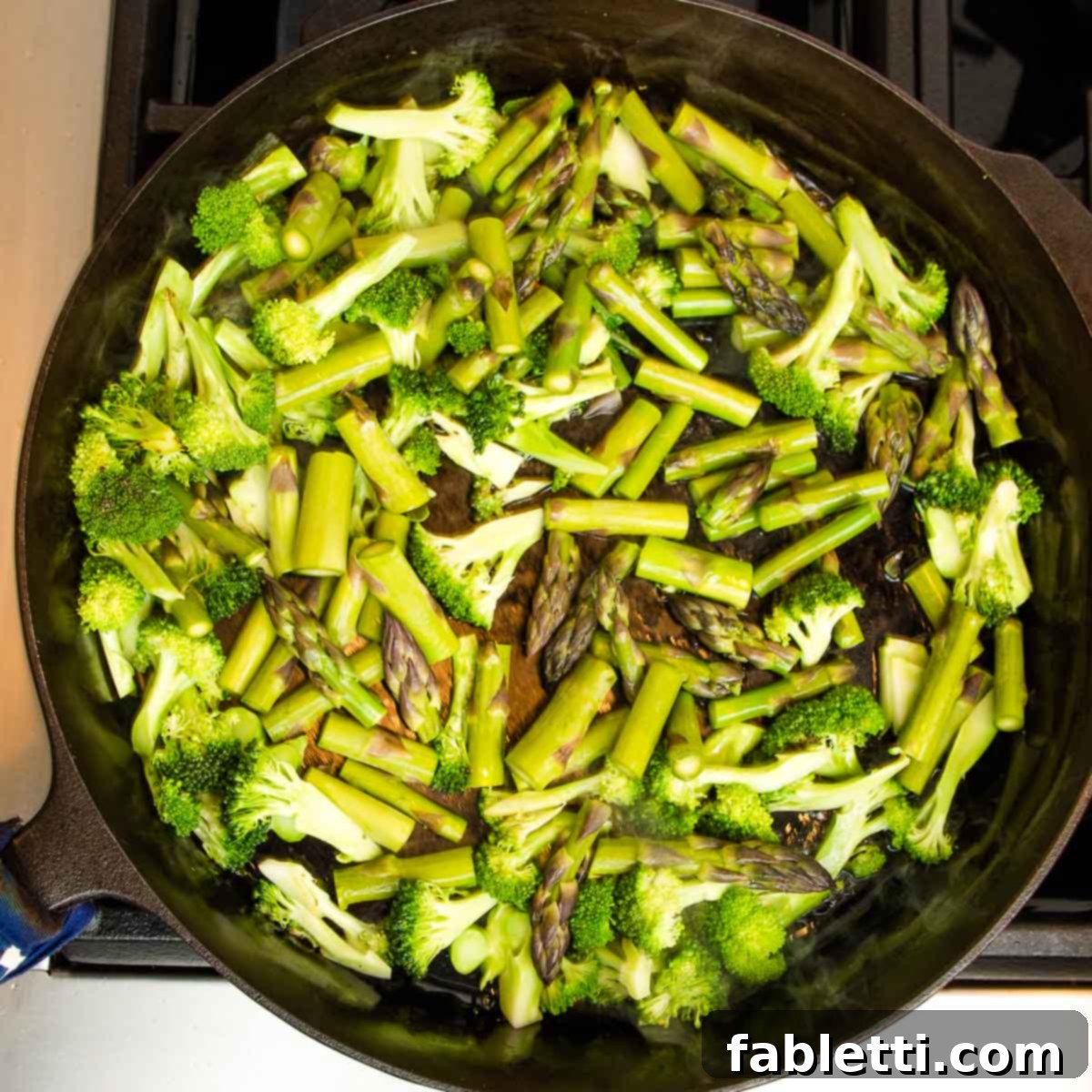

For our vegetable lineup, begin by adding the thinly sliced broccoli stalk spheres, followed by any thicker asparagus pieces. Allow these to cook for about a minute, stirring frequently. Next, introduce the broccoli florets into the pan. After another minute, stir in the sliced red onions. If your pan starts to look dry, add 1-2 tablespoons of white wine, vegetable stock, or additional pasta water to keep the vegetables cooking without scorching, contributing to a flavorful deglazing.


Continue building your vegetable base by adding the zucchini half-moons and red bell pepper strips. Toss all the vegetables together thoroughly, ensuring an even distribution and cooking. Again, if the pan appears dry, don’t hesitate to add another tablespoon of liquid. While the alcohol in white wine will cook off, imparting a wonderful depth of flavor, you can easily substitute it with vegetable broth if you prefer an alcohol-free dish.
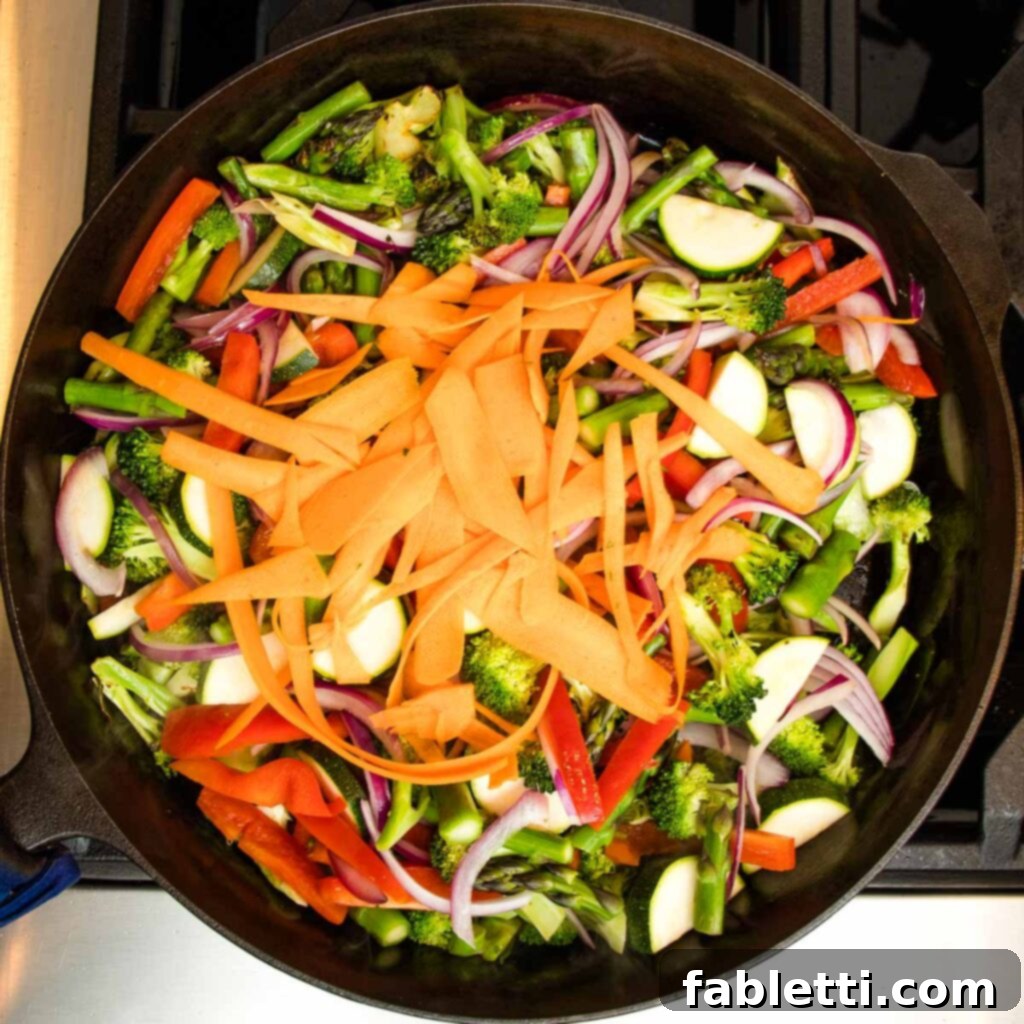
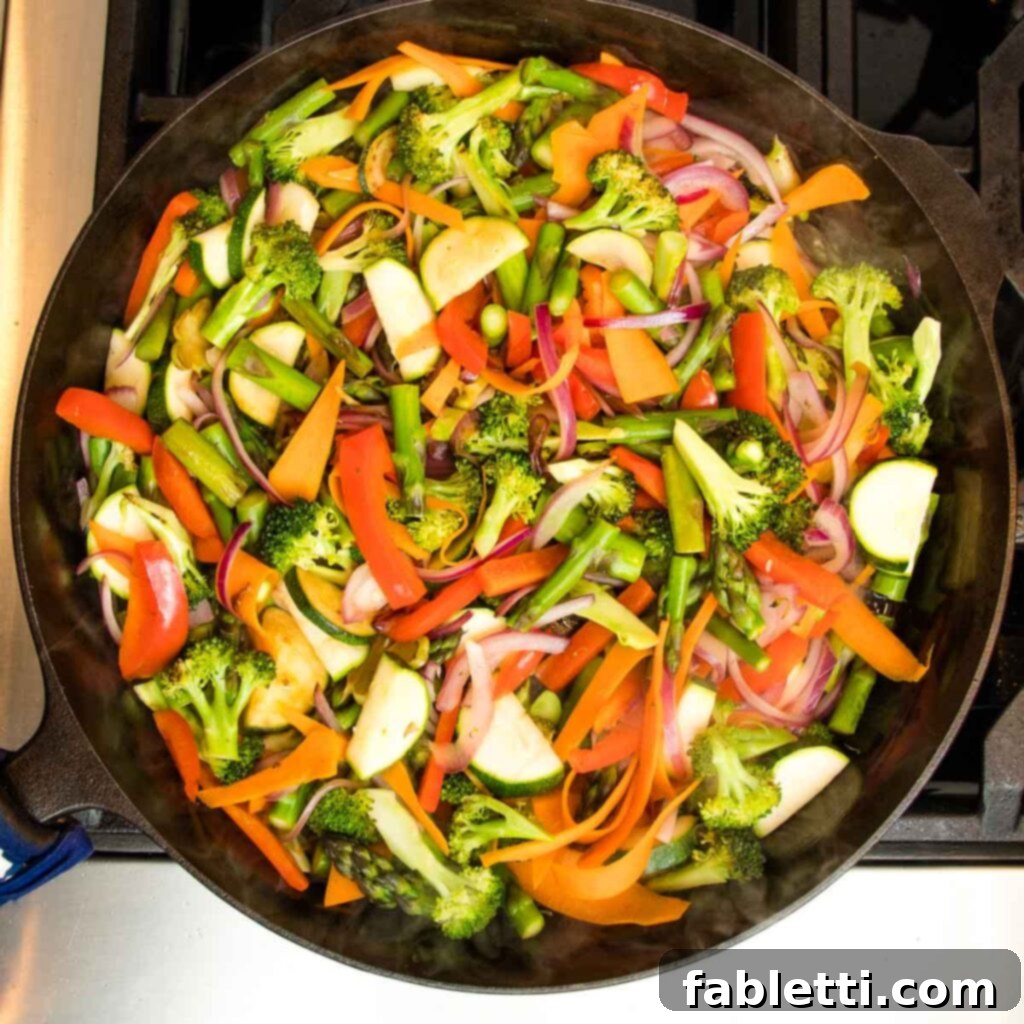
Finally, incorporate the delicate carrot ribbons into your vibrant vegetable mixture. At this stage, sprinkle in 1 teaspoon of dried Italian seasoning. Toss everything together, allowing the aromatic herbs to meld with the fresh vegetables, creating an enticing fragrance and enhancing the overall flavor profile of your primavera.

Once your vegetables are bright, tender, but still possess a delightful crispness – ensuring they’re not mushy – it’s time to unite them with our creamy sauce. Pour about half of the prepared tahini lemon sauce over the sautéed vegetables and stir well to coat every piece evenly. This initial coating ensures maximum flavor distribution.
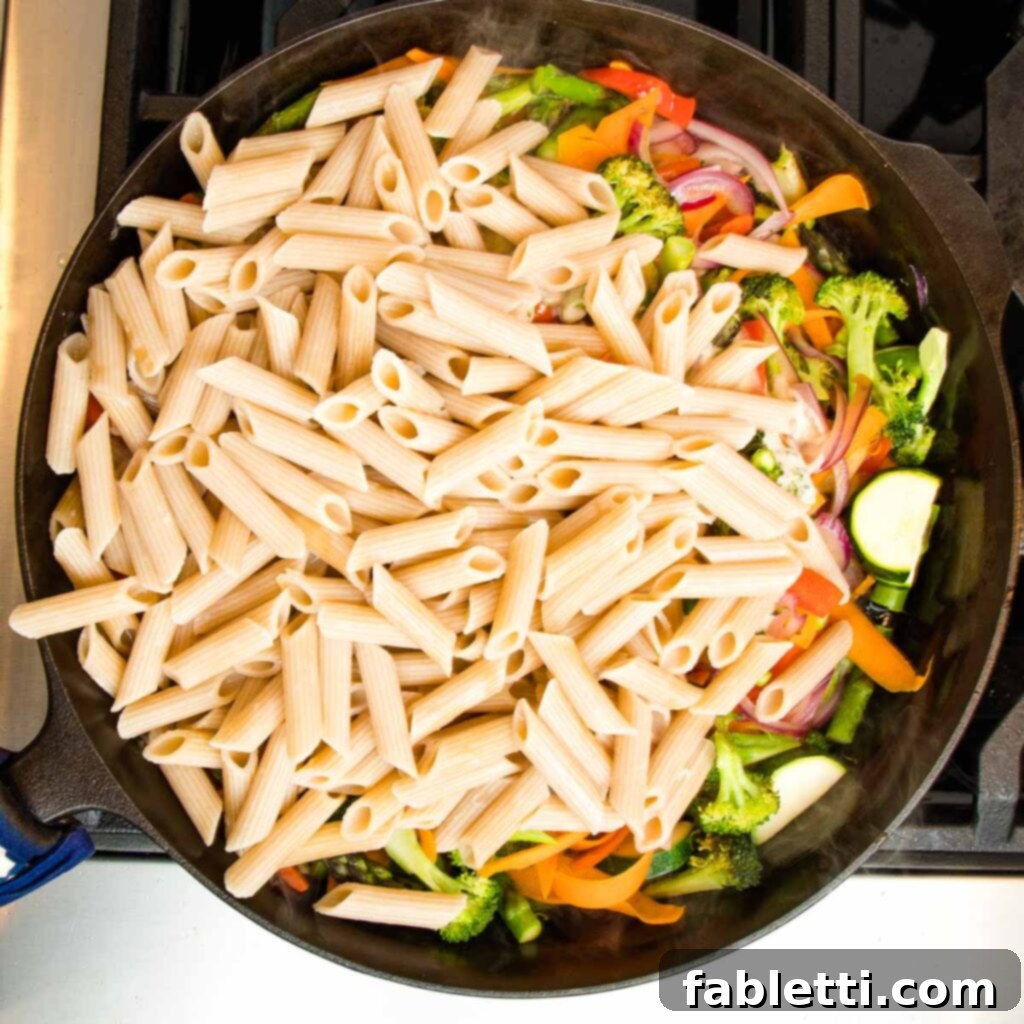
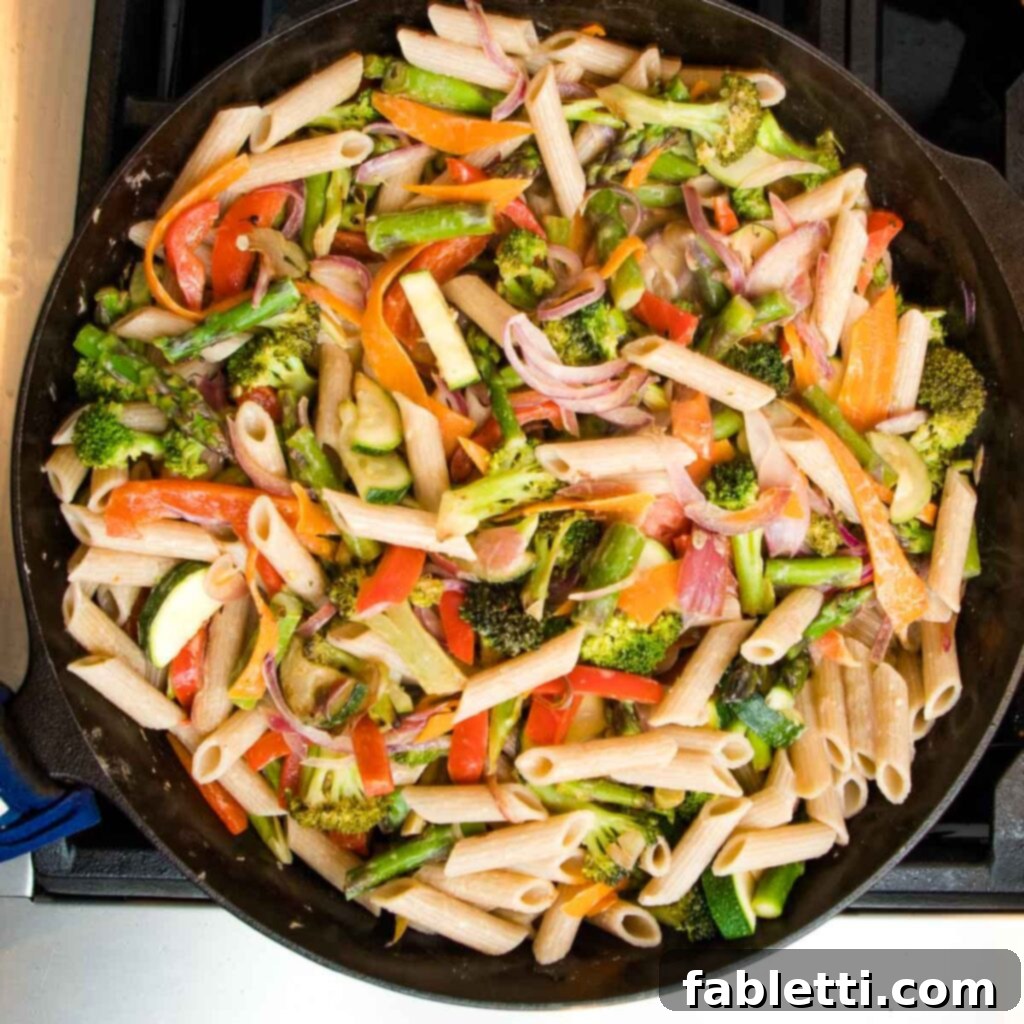
If you’re using a large enough skillet, you can directly add the drained, al dente pasta to the vegetable mixture and toss everything together until beautifully combined. If your skillet isn’t quite big enough, simply transfer the cooked vegetable mixture into the pot you used to boil the pasta. Add the drained pasta to this pot, then pour in the remaining sauce, and mix thoroughly until the pasta and vegetables are evenly coated in the luscious primavera sauce.
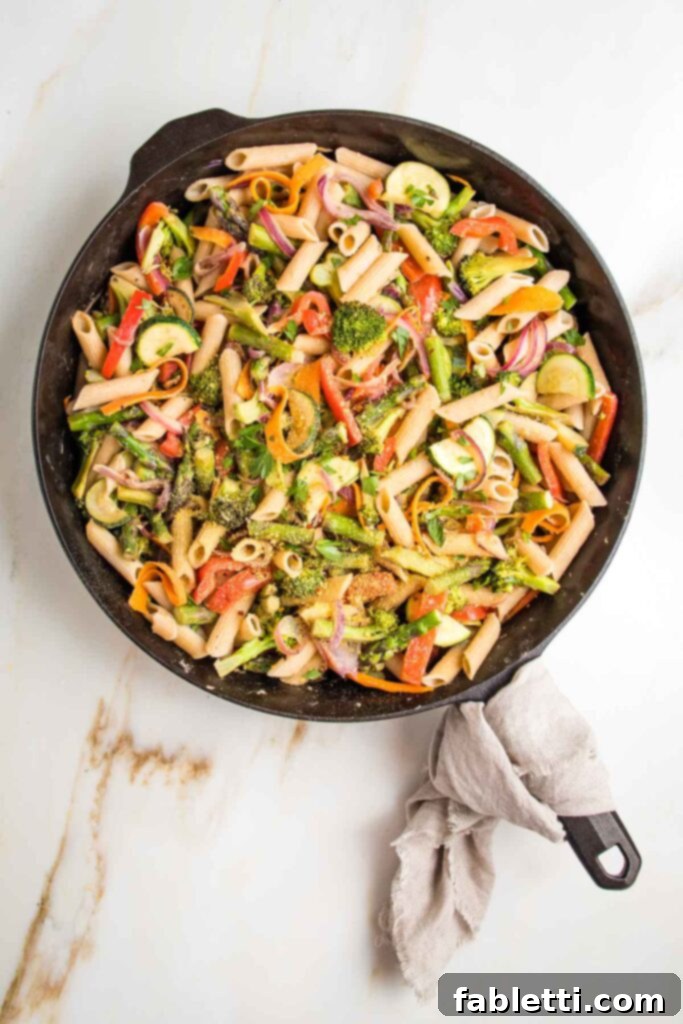
To finish, sprinkle on the reserved nutritional yeast for an extra layer of “cheesy” flavor, along with a generous scattering of fresh chopped herbs. For an additional burst of brightness, squeeze a little fresh lemon juice over the top just before serving. Serve your Vegan Pasta Primavera warm, inviting everyone to add extra crushed red pepper flakes if they desire a touch more heat. Enjoy this wholesome, flavorful dish that’s sure to impress!

Meal Prep and Storage Solutions
Planning ahead makes healthy eating even easier. Here’s how to manage your Vegan Pasta Primavera for maximum freshness and convenience:
- Serving Suggestions: This recipe is designed to serve 4 as a satisfying vegan main dish. If you’re looking to stretch it further or serve it as a lighter side, it can easily accommodate 4 portions in that capacity too. For a heartier meal, consider adding even more fresh veggies or incorporating small white beans for extra protein and fiber. While this dish truly shines when served warm, its flavors also make it an excellent cold pasta salad, perfect for picnics or packed lunches.
- Prepare Ahead: Streamline your cooking process by prepping components in advance. All the vegetables can be chopped and stored in an airtight container in the refrigerator for up to 2-3 days until you’re ready to cook. The vibrant primavera sauce can also be made up to 3 days in advance. If making the sauce ahead, use vegetable broth instead of pasta water for thinning. Store it in a lidded glass jar in the fridge. Before combining with the tender veggies, add a splash of pasta water or vegetable broth and whisk to warm it up and restore its smooth consistency.
- Storing Leftovers: Any leftover pasta primavera should be stored in an airtight container in the refrigerator for up to 5 days. For reheating, gently warm the pasta in a heavy skillet on the stove over medium-low heat. Add a tablespoon or two of white wine, lemon juice, or vegetable broth to help loosen the sauce and bring back its fresh flavor without drying out the pasta or vegetables.
- Freezing: Unfortunately, this dish does not freeze well. The delicate texture of the vegetables and pasta can become compromised upon thawing, resulting in a less-than-ideal consistency. It’s best enjoyed freshly made or within a few days of preparation from the refrigerator.
Debra’s Pro Tips for Primavera Perfection

Elevate your Vegan Pasta Primavera with these expert insights and tricks:
- Versatile Serving Temperatures: While typically enjoyed warm, this pasta primavera is equally delightful served cold as a refreshing pasta salad. It’s a fantastic option for meal prep, picnics, or summer lunches.
- Gluten-Free Excellence: Wondering if Gluten-free Pasta Primavera truly tastes good? Absolutely! Opting for gluten-free pasta in this recipe is a fantastic choice, just be vigilant about cooking times. Set your timer for 2 minutes LESS than the package directions suggest to ensure your pasta achieves that perfect al dente texture without becoming mushy.
- Strategic Veggie Sautéing: The order in which you add vegetables to the pan is critical for uniform cooking. Always start with denser vegetables that require more time, and gradually add softer, quicker-cooking ones. For instance, if your asparagus spears are thick, add them earlier. Super thin asparagus or delicate carrot ribbons, however, should be added at the very end to achieve tender, al dente perfection. Similarly, ¼-inch carrot rounds will need more time and should go in near the beginning, while thin ribbons are best incorporated at the last minute.
- Flexibility with Vegetables: The suggested 5 cups of assorted vegetables provides plenty of flexibility. Don’t stress if you don’t have every single vegetable listed; use what’s fresh, in season, and available to you. This recipe is wonderfully adaptable to your pantry and preferences.
- Scaling Up for Crowds: If you need to feed more people, this recipe doubles beautifully! Simply double the quantities of both the sauce and the vegetables to ensure a generous and satisfying meal for everyone.
- Embrace Extra Sauce: Don’t be shy about making a little extra sauce! It can be passed around at the table for those who enjoy a saucier dish. Any additional sauce stores well in the fridge and is perfect for reheating leftover primavera on the stove, ensuring every serving is as rich and creamy as the first.
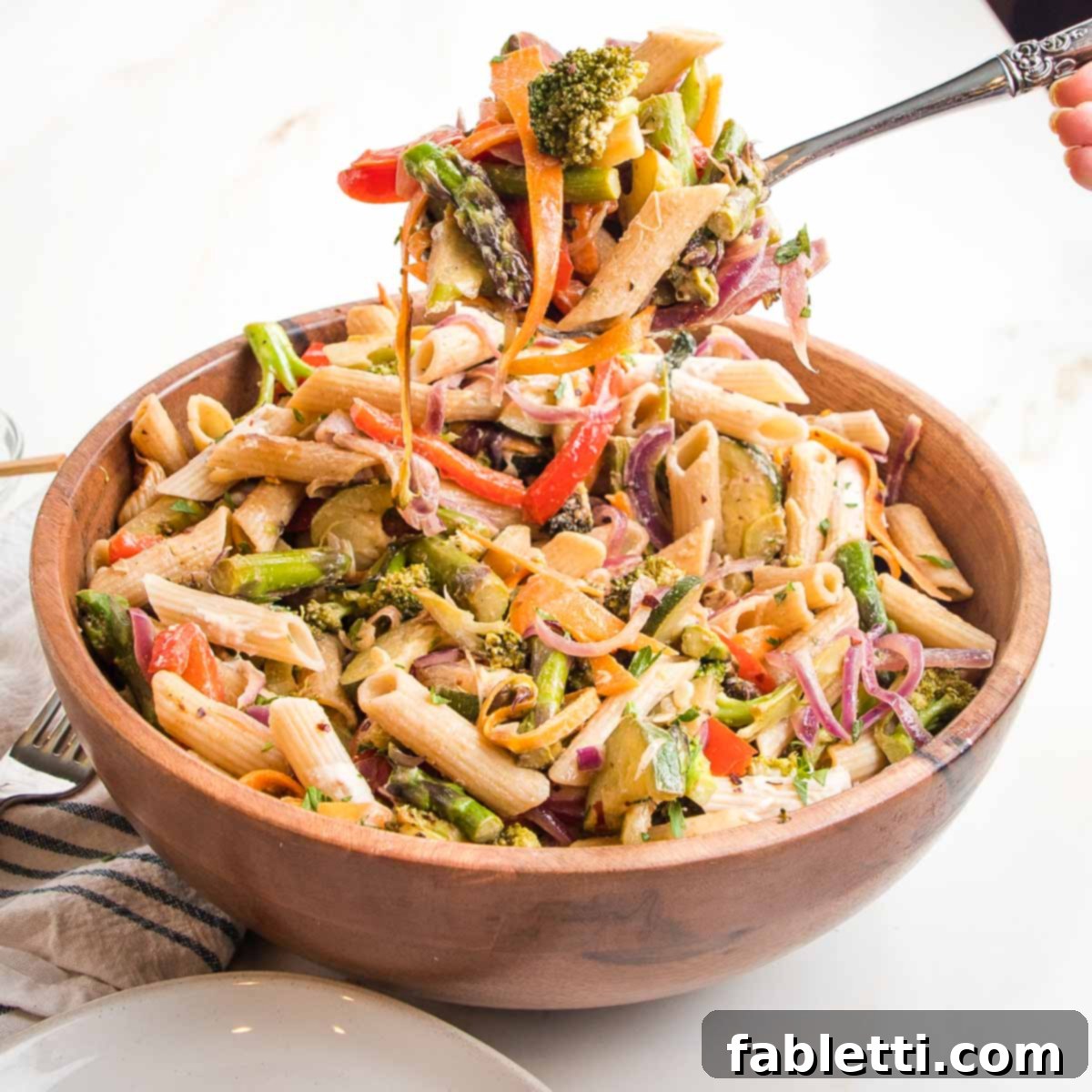
Discover More Delicious Vegan Italian Main Dish Recipes:
- Vegan Zucchini Rollatini (gluten-free)
- Vegan Stuffed Peppers with Lentils
- Hearty Vegan Stuffed Zucchini Boats
- Gluten-free and Vegan Vegetable Lasagna
Your support means the world to us! Commenting on and rating recipes is one of the best ways to help your favorite food bloggers. If you’ve tried this delightful Vegan Pasta Primavera, please consider leaving a five-star rating and a comment below to share your experience. We would also love to see your beautiful creations! Share your photos on Instagramby tagging me @dkhealthcoach and using the hashtag #debraklein. Thank you for being a part of our culinary community!
📖 Recipe

Vegan Pasta Primavera
Pin Recipe
Equipment
- Mini whisks
- Cast iron skillet
- Citrus Squeezers
- Pyrex Glass Measuring Cup Set
Ingredients
- 1 lb. gluten-free pasta*
- 1 Tablespoon olive oil
- 1 medium red onion sliced thin
- 1 red bell pepper cut into thin strips
- 2 broccoli crowns cut into florets
- 1 medium zucchini cut into half moons
- 1 large carrot peeled into long, thin strips
- 1 bunch asparagus cut into 1″ pieces
- 1 teaspoon dried Italian seasoning
- 2-3 Tablespoons white wine (or vegetable broth)
Pasta Primavera Sauce
- ¼ cup tahini
- 1 lemon juiced
- ½ teaspoon coarse sea salt
- ¼ teaspoon crushed red pepper
- ½ cup pasta water (reserved from cooking)
Garnish
- ¼ cup chopped fresh parsley
- 1 Tablespoon nutritional yeast
Instructions
- PREP THE VEGGIES: Meticulously prepare all your vegetables. Cut the red onion in half, peel, and then slice into thin strips. Stem and seed the red bell pepper, then chop it into thin, even strips. Thinly slice the stalks of fresh broccoli, then separate the crowns into uniform florets. Trim the ends off the zucchini, slice it in half lengthwise, and then cut it into ½-inch half moons. Trim and peel the carrot, then use a vegetable peeler to create long, thin strips (or cut into ¼-inch discs for a longer cooking time). Finally, trim the woody ends from the asparagus and cut the spears into 1-inch pieces. Keep all prepped vegetables separate, as they will be added to the pan in a specific order.
- Bring a large pot of generously salted water to a rolling boil. Add your chosen pasta and cook according to package directions, but be careful not to overcook. This easy pasta primavera tastes best when the pasta is perfectly al dente, meaning it has a slight bite. Generally, this will be 2 minutes LESS cooking time than indicated on the package. Stir the pasta once or twice during cooking to prevent it from clumping together. Before draining, remember to reserve 1 cup of the starchy pasta cooking water. Drain the pasta and set it aside.
- MAKE THE PRIMAVERA SAUCE: In a medium bowl, whisk together the tahini, fresh lemon juice, coarse sea salt, and crushed red pepper flakes until smooth. Using a Pyrex glass measuring cup, slowly pour ½ cup of the reserved pasta water into the tahini mixture while continuously whisking. This helps to thin the sauce to a creamy, pourable consistency. If the sauce still seems too thick, add a bit more pasta water, one tablespoon at a time, until it reaches your desired texture. Set the completed sauce aside.
- Heat a large, heavy skillet (cast iron works wonderfully) over medium-high heat. Swirl in about 1 tablespoon of olive oil or a splash of pasta water/vegetable broth to prevent sticking. Begin adding your fresh vegetables to the pan in order of their cooking time, starting with those that take longer to become tender: first the broccoli stalk spheres, then asparagus (especially if thicker), followed by broccoli florets. Allow each addition to cook for about a minute, tossing with large tongs, before moving on. Next, add the red onions, zucchini, and red bell peppers, tossing well to combine. If the pan becomes too dry during this sautéing process, add 1-2 tablespoons of white wine or vegetable broth to deglaze and keep the vegetables cooking. Finally, incorporate the carrot ribbons and sprinkle in the dried Italian seasoning. Continue to toss and cook until all the vegetables are bright in color and still crisp-tender, not mushy.
- Once the vegetables are perfectly cooked, pour about half of the prepared tahini lemon sauce over them and stir thoroughly to coat. If your skillet is large enough, add the cooked and drained pasta directly to the pan and mix everything well. Alternatively, transfer the cooked vegetable mixture into the pot the pasta was boiled in, then add the drained pasta and the remaining sauce. Toss vigorously until the pasta and vegetables are evenly coated in the creamy primavera sauce. Serve warm, garnished with a generous sprinkle of nutritional yeast, fresh chopped parsley, and, if desired, some sliced green onions or an extra squeeze of fresh lemon juice to taste.
Notes
VEGETABLE VARIATIONS: The wonderful aspect of this easy vegan pasta primavera recipe is its adaptability to seasonal vegetables. While the photos feature vibrant fresh spring vegetables, you are encouraged to use whatever seasonal produce is readily available at your local grocery store or farmer’s market. Other fantastic additions to this classic Italian dish could include crisp green beans, sweet green peas, delicate snow peas or snap peas, tender yellow squash, halved cherry tomatoes, fresh basil, or any other fresh herbs you have on hand that complement Italian flavors.
Nutrition
Note
The nutrition calculations were done using online tools. To obtain the most accurate representation of the nutritional information in any given recipe, you should calculate the nutritional information with the actual ingredients you used. You are ultimately responsible for ensuring that any nutritional information is accurate, complete and useful.
